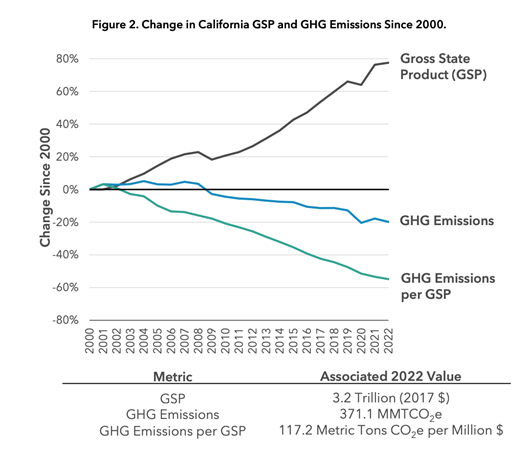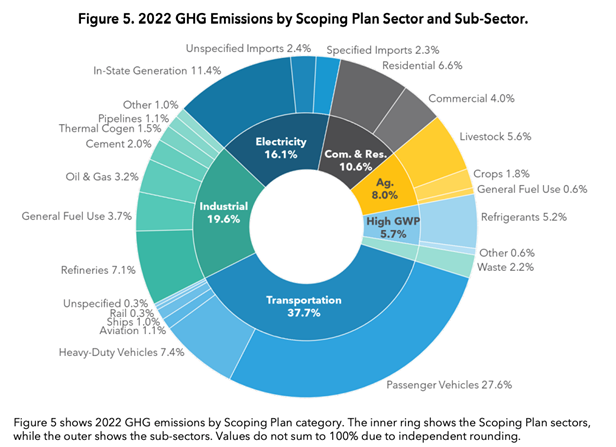Nearly a decade ago, we committed California to cutting greenhouse gas emissions 40% below 1990 levels by 2030. It was a bold move, but bold moves are part of our DNA in California. Now, with 2030 just five years away, it’s time to ask: Are we on track?
The latest data from the California Air Resources Board (CARB) shows we’ve made real progress. In 2022 (the latest year for which we have results), emissions dropped to 371.1 million metric tons of CO₂-equivalent (MMTCO₂e), the lowest in decades and a 24% reduction since 2000. That’s a big deal.
Over that same period, our economy grew by 77.5%. The message from this is clear, solving climate action and supporting economic growth are not at odds. In fact, they can move together. Today, California emits 55% less climate pollution for every dollar of economic output than it did in 2000.

But let’s be clear: we’re still 111 MMTCO₂e/year above our 2030 target. To close that gap, we’ll need to double the pace of reductions, cutting roughly 15 million tons every year between now and the end of the decade. Is that achievable?
In some sectors, yes. Our electricity grid is getting cleaner, thanks to solar, wind, and energy efficiency. Transportation emissions from road vehicles are declining as electric vehicles and cleaner fuels scale up. But in many areas, we’re not moving fast enough. And in some, we haven’t yet built momentum.
Where strong policies are in place, like Advanced Clean Cars or all-electric building codes, we’re heading in the right direction. But switching out cars, water heaters, and furnaces takes time, and that slows short-term progress. In these sectors, our job is to streamline permitting, scale incentives, and speed up the transition.
Other sectors, like industrial decarbonization, are only just beginning the journey. Here, we need new tools, bigger interventions, and more focused attention to kickstart progress.
So: are we on track? It depends where you look. Let’s break it down, sector by sector.

Transportation (37.7% of emissions)
Good news
On-road transportation emissions dropped 4.2% in 2022, and biofuels now make up nearly 70% of diesel used on the road. Zero-emission vehicle adoption continues to grow rapidly, supported by state incentives.
Bad news
Intrastate aviation emissions rose 21.7%, and we still drive a lot of miles, especially in areas without good transit or housing near jobs.
2030 challenge
We must keep scaling EVs while also reducing vehicle miles traveled, particularly by aligning housing, jobs, and transportation planning. That means investments in smart growth, transit, and local mobility.
Electricity (16.1%)
Good news
Emissions are falling ~4% a year even as demand rises, thanks to record growth in solar, wind, and battery storage.
Bad news
Electricity is getting too expensive, and that’s now a barrier to electrifying vehicles, buildings, and other sectors. We’re also struggling to bring on new clean power fast enough to meet the needs of data centers, EV chargers, and housing.
2030 challenge
This year, we’re tackling that challenge head-on with 3 bills: SB 541 helps open up near-term grid capacity by shifting flexible loads off peak hours, creating headroom for new demand. SB 540 supports the creation of a wider western electricity market that can reduce the cost of generation, improve reliability, and lower GHG emissions. And SB 254 includes a set of 9 reforms, including public financing of major transmission projects to reduce the cost to build critical infrastructure, clean energy permitting reforms to accelerate projects and lower costs, and better cost/risk analysis for wildfire prevention spending to get more “bang for the buck” from this large category of utility expense. There is no one silver bullet for reducing electricity costs, but these three bills will save consumers billions of dollars annually and help us to accelerate electrification of the whole economy.
Industrial (19.6%)
Good news
Emissions are at an all-time low, with a 7% drop in oil and gas production year-over-year.
Bad news
Refineries, cement, and other industrial facilities remain major emitters, and we lack a comprehensive decarbonization strategy for this sector.
2030 challenge
We need bigger interventions. That could include electrifying industrial heat loads using thermal energy storage to soak up midday solar and provide clean 24/7 heat. Last year we introduced this idea with my bills SB 1018 and SB 993—and this year, AB 388 (Asm. Rogers) aimed to continue that effort.
Buildings (10.6%)
Good news
Stronger building codes and appliance standards are driving down emissions per home and per square foot.
Bad news
Commercial emissions jumped 5.6% last year, and gas is still dominant for space and water heating in many parts of the state.
2030 challenge
The goal is straightforward, electrify everything. But even with the right policies in place, adoption takes time. We need to double down on removing barriers to heat pumps, induction stoves, and all-electric retrofits, while continuing to target methane leaks from gas infrastructure.
Agriculture (8.0%)
Good news
Methane from livestock is down 12.6% from its 2012 peak, and digesters are increasingly common on dairies.
Bad news
Methane from livestock and nitrous oxide from fertilizer remain hard to abate.
2030 challenge
One big lever is new feed additives or vaccines that cut methane from cows—but California needs federal approval to use them at scale. That’s why I’m championing SJR-5, urging the FDA to act swiftly so we can deploy these tools.
High-GWP Gases (5.7%)
Good news
After two decades of rising emissions, refrigerant pollution has stabilized.
Bad news
These gases are still potent, and equipment turnover is slow.
2030 challenge
We need to enforce phase-down rules already on the books and create incentives for faster replacement with low-GWP systems in commercial and residential buildings.
Recycling & Waste (2.2%)
Good news
Methane from landfills is trending downward, thanks to improved gas capture and organics diversion.
Bad news
Waste volumes are rising again, especially post-COVID, and we still landfill far too much organic material.
2030 challenge
We must scale composting, improve organic waste diversion, and invest in infrastructure to cut landfill emissions and boost soil health.
The Path Forward
We’ve already cut 117 million tons of emissions since 2004, but to hit our 2030 target, we need to cut that much again in just eight years.
Some sectors are already gaining speed. Our job is to streamline permitting, align incentives, and scale what’s working. In others, we need to jumpstart progress with bold new policy moves. The good news is that today, we know what to do.
Most of the tools we need are already in the toolbox. The momentum is building. And California, as always, is ready to lead.
We’re re-launching this blog to track both the progress and the roadblocks, to look under the hood and explore what it really takes to get to zero. We'll highlight where momentum is building, where policy needs to catch up, and how we can close the gap together.
Authored by Senator Josh Becker in Collaboration with Joby Bernstein